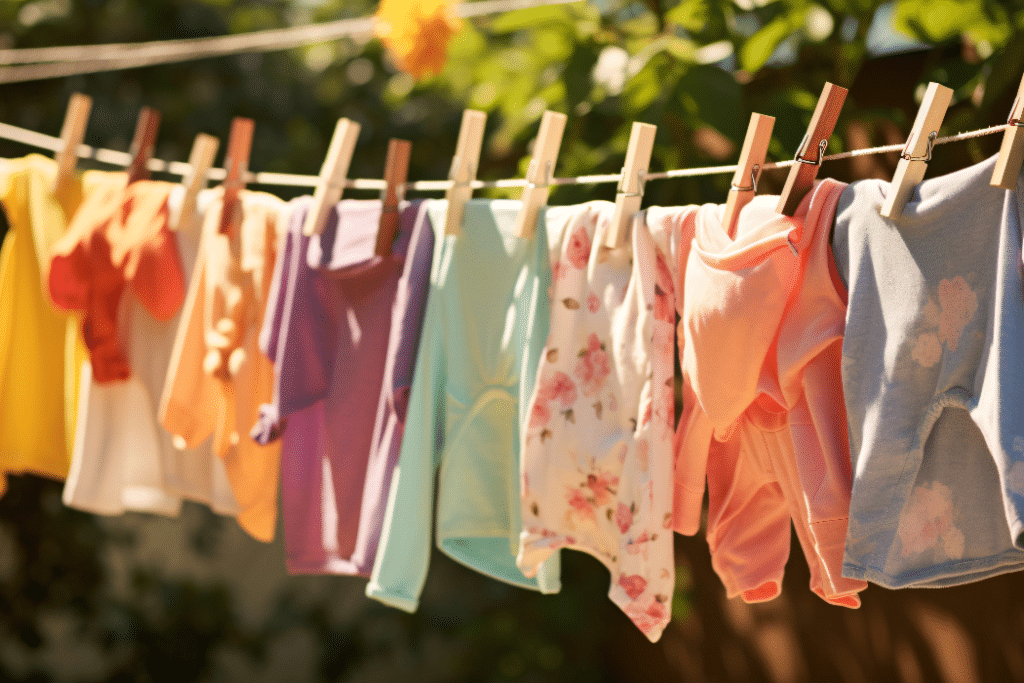The clothes on our backs, the sheets on our bed, and the upholstery on our furniture don’t just determine our aesthetic and comfort. Chemicals that we can’t pronounce, much less want near our skin, have wormed their way into the fabric of our daily lives. Increasingly, these choices affect our health, our environment, and our collective future.
It’s a quiet, persistent concern: Are the textiles we bring into our homes safe? Sustainable? Free from harmful substances?
Looking for the OEKO-TEX certification can help answer all of those questions. Read on to understand just what OEKO-TEX certified products promise and why that should matter to you and your family.
What is the Meaning of OEKO-TEX?
OEKO-TEX is an independent certification system that rigorously tests textiles at all stages of production — from raw materials to the finished product — to ensure they are free from harmful substances. Common OEKO-TEX certified products include clothing, bedding and home textiles, children’s products, and footwear.
The foundation of OEKO-TEX is its commitment to consumer safety and eco-friendly production. The certification evaluates textiles for over 100 potentially harmful substances, ranging from carcinogenic colorants to pesticides and heavy metals. The skin is the body’s largest organ, and any harmful substances in textiles can be absorbed through it (1). OEKO-TEX certified products reduce the risk of skin irritations, allergies, and other health issues associated with chemical exposure (2).
The certification doesn’t just stop at the product. OEKO-TEX also examines the processes employed in textile production. Through its stringent criteria, it ensures that certified textiles minimize environmental impact through several means:
- Water Protection: OEKO-TEX products must adhere to wastewater guidelines, thereby reducing water pollutants. This protects aquatic life and promotes clean water initiatives.
- Reducing Air Pollution: OEKO-TEX standards restrict the use of volatile organic compounds (VOCs) and other pollutants that can affect air quality.
- Encouraging Responsible Resource Use: OEKO-TEX’s criteria promote the responsible use of resources, pushing textile manufacturers to optimize raw material use, reduce waste, and recycle where possible.
- Promoting Transparency and Accountability: The rigorous testing and transparency OEKO-TEX brings to the textile industry make manufacturers more accountable for their environmental footprint. This, in turn, encourages companies to adopt more eco-friendly practices and innovations.
What Chemicals are Banned by OEKO-TEX?
OEKO-TEX bans or regulates the use of over 100 harmful chemicals in textiles. Banned substances include Azo dyes, formaldehyde, pentachlorophenol, cadmium, and nickel.
- Azo Dyes: These synthetic compounds are used to color textiles and leathers. However, some Azo dyes can break down to release carcinogenic aromatic amines (3). This has caused many countries to ban or restrict the use of Azo dyes.
- Formaldehyde: A volatile organic compound (VOC) that releases harmful fumes, formaldehyde is known for its preservative and anti-wrinkle properties. Extended exposure can cause respiratory issues, skin irritation, and even cancer (4).
- Pentachlorophenol (PCP): Once a popular pesticide and disinfectant, PCP is now known for its toxicity to humans. It’s been linked to liver and kidney damage when absorbed by the human body (5). PCP is also persistent in the environment, meaning it remains for a long time after its release.
- Cadmium: A heavy metal, cadmium is sometimes used in textile dyeing processes. However, it’s highly toxic when ingested or inhaled and can accumulate in the human body, leading to organ damage over time (6).
- Nickel: Often used in metal accessories like buttons and zippers, nickel is the leading cause of allergic contact dermatitis, an itchy skin rash similar to poison ivy (7).
The substances that OEKO-TEX restricts or bans are not just random chemicals. Each of them poses tangible health risks, making the certification an essential consideration for those aiming for safer, healthier textiles.
What Materials Can Be OEKO-TEX Certified?
OEKO-TEX certifies a broad range of textiles, from raw materials like fibers to end products such as garments, home textiles, and even accessories. Essentially, any textile material or product can be OEKO-TEX certified as long as it meets the required safety and environmental criteria.
- Raw Materials: All raw materials are eligible. This includes natural fibers such as cotton, wool, and silk, as well as synthetic fibers like polyester, nylon, and elastane
- Intermediate Products: This includes items like yarns, woven fabrics, knits, and non-wovens
- Finished Products: Clothing items from shirts to pants, home textiles like bed linens, towels, and even certain accessories such as bags and hats
- Accessory Materials: Zippers, buttons, threads, and labels – components that might be overlooked but are crucial to the overall safety and sustainability of a textile product
This comprehensive approach ensures that certified products are safer for consumers, workers, and the planet.
What is OEKO-TEX Cotton Fabric?
OEKO-TEX cotton fabric refers to cotton material that has undergone rigorous testing to ensure it is free from harmful levels of 100+ chemicals. The chemicals screened by OEKO-TEX are known to be detrimental to human health.
For cotton to be OEKO-TEX certified, every stage of its production – from the sowing of seeds to the dyeing of fibers – is scrutinized. This means that farmers avoid using toxic pesticides and fertilizers, and manufacturers abstain from harmful dyes and finishers.
OEKO-TEX certified cotton fabric is gentle on the skin, making it an excellent choice for those with sensitive skin or allergies. The lack of harsh chemicals and irritants means the fabric is less likely to cause rashes, irritations, or allergic reactions (8).
The benefits of OEKO-TEX cotton don’t stop at our bodies. When cotton is produced without harmful chemicals, it also means less pollution in our waterways, soil, and air. Certified OEKO-TEX cotton fabric must meet specific criteria for responsible and sustainable production practices, including environmentally-friendly manufacturing and responsible water usage.
In a market where many claims are made about “natural” and “organic” products, OEKO-TEX certified cotton stands out as a clear indicator of safety, sustainability, and responsibility.
Does OEKO-TEX Mean Non-Toxic?
Yes, OEKO-TEX certification means that the textile product has been tested for harmful substances and is free from toxic levels of more than 100 known chemicals that can be detrimental to human health. To achieve OEKO-TEX certification, textiles undergo rigorous testing to identify and quantify any chemical substances. This ensures that no harmful chemicals are present above the established safe limits.
Non-toxicity isn’t just about chemical presence. It also means that during the textile’s production, no processes or treatments were used that might introduce harmful agents. OEKO-TEX’s stringent standards ensure that every phase of production, from raw material sourcing to final product, is clean and safe.
Does OEKO-TEX Mean Hypoallergenic?
No, while OEKO-TEX certification ensures textiles are free from harmful levels of chemicals, it does not specifically guarantee that a product is hypoallergenic. However, by eliminating many substances that can cause reactions, OEKO-TEX certified textiles are less likely to cause allergic responses.
Many individuals suffer from allergies related to specific chemicals, dyes, or textile finishes. These allergies can manifest as skin irritations, respiratory problems, or other health issues when in contact with certain materials. By banning or regulating harmful chemicals, OEKO-TEX inherently reduces or eliminates common allergens in certified textiles.
It’s crucial for consumers to understand that “hypoallergenic” doesn’t necessarily mean a product is free from all chemicals or substances. It merely suggests a reduced potential for causing allergic reactions. There can still be instances where an individual may be allergic to a substance that is present even in hypoallergenic items.
While certifications like OEKO-TEX provide a level of assurance, individuals with severe allergies or sensitivities should always exercise caution. Reading labels, conducting patch tests, or consulting with medical professionals can be wise steps before using any textile product.
Benefits of Buying OEKO-TEX Certified Products
Navigating the vast textile market today can feel overwhelming, especially with the increasing health and environmental concerns. Here’s why choosing OEKO-TEX certified products can make a difference:
Product Safety
- For Everyone: OEKO-TEX certification offers peace of mind to consumers that they’re purchasing products that have undergone rigorous testing. The guarantee is that these textiles are free from an extensive list of harmful substances, ensuring they’re safe for human use.
- For Sensitive Individuals: People with allergies, sensitivities, or skin conditions especially benefit from OEKO-TEX certified products. Reducing the potential allergens and irritants in textiles can make a significant difference in comfort and health for these individuals.
- Child and Baby Safety: Similarly, since children’s skin is more sensitive, choosing OEKO-TEX certified textiles for kids and babies ensures that the fabrics in close contact with their skin are free from harmful chemicals.
Environmentally Responsible:
- Reduction of Harmful Chemicals: OEKO-TEX’s stringent standards mean fewer harmful chemicals are used in the production process. This reduction benefits not only the end-users but also the environment by reducing pollution and chemical waste.
- Supporting Ethical Brands: Brands that seek OEKO-TEX certification often prioritize ethical and sustainable practices. By choosing certified products, consumers indirectly promote responsible production.
With all the choices available to consumers today, certifications like OEKO-TEX can play a pivotal role in guiding you to a healthier and more sustainable purchase.
OEKO-TEX vs. Other Certifications
With an increasing emphasis on sustainability and health in the textile industry, several certifications have emerged to help guide consumers. Understanding the nuances of each can help in making informed choices.
Global Organic Textile Standard (GOTS):
- Focus: GOTS primarily emphasizes the organic sourcing and processing of textiles. It ensures that the fibers are derived from organic sources and the entire production process, from harvesting to labeling, adheres to strict environmental and social criteria.
- Comparison with OEKO-TEX: While GOTS assures organic practices, OEKO-TEX focuses more on the end product being free from harmful substances. It’s possible for a product to have both certifications if it’s both organic and free from harmful chemicals.
- Focus: Fair Trade prioritizes the social aspects of production. It ensures that workers receive fair wages, work in safe conditions, and are given rights
- Comparison with OEKO-TEX: OEKO-TEX doesn’t delve into labor practices; its main concern is the chemical safety of textiles. A product can be both Fair Trade certified and OEKO-TEX certified, indicating both ethical labor practices and chemical safety.
Made in Green by OEKO-TEX:
- Focus: Made in Green is another certification by OEKO-TEX, but it combines eco-friendly production processes with the standard assurance that the end product is free from harmful substances.
- Comparison with OEKO-TEX: While both are from the same entity, the Made in Green label is more comprehensive since it provides additional assurances about eco-friendly production.
While each textile certification has its strengths and areas of focus, OEKO-TEX stands out with its unwavering commitment to human health and safety.
The Impact of Informed Purchasing
In our incredibly interconnected world, choices in something as everyday as textile purchasing can have profound implications. Supporting OEKO-TEX certified products means making safer individual choices, but also stands for a commitment to our broader, collective well-being.
By driving manufacturers to adopt safer methods, we drive a shift toward a more sustainable and health-conscious industry. A reduction in harmful substances in textiles lessens the risk of environmental damage during production and disposal, ensuring our planet benefits as much as our own personal health.
Through our purchase decisions, we each become an advocate for change, paving the way for a future where safety and sustainability are prioritized by every product we bring into our homes.
References
- “Skin.” Cleveland Clinic, 2021. https://my.clevelandclinic.org/health/articles/10978-skin
- “Am I Allergic to my Clothes?” WebMD, 2022. https://www.webmd.com/allergies/textile-allergy
- “Azo dyes and human health: A review.” NIH, 2016. https://pubmed.ncbi.nlm.nih.gov/27635691/
- “Formaldehyde.” National Cancer Institute, 2022. https://www.cancer.gov/about-cancer/causes-prevention/risk/substances/formaldehyde
- “Human pentachlorophenol poisoning.” NIH, 1993. https://pubmed.ncbi.nlm.nih.gov/7904464/
- “The toxicity of cadmium and resulting hazards for human health.” NIH, 2006. https://www.ncbi.nlm.nih.gov/pmc/articles/PMC1578573/
- “Two Cents about Nickel Allergy.” American Academy of Allergy, Asthma, and Immunology. https://www.aaaai.org/tools-for-the-public/conditions-library/allergies/nickel
- “Allergies caused by textiles: control, research and future perspective in the medical field.” International Immunopharmacology, 2022. https://www.sciencedirect.com/science/article/pii/S1567576922005276




